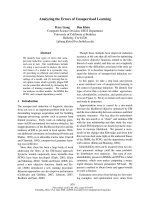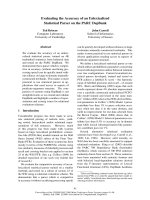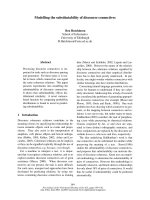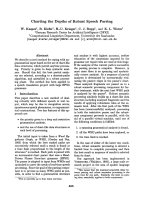báo cáo khoa học: " Curbing the menace of antimicrobial resistance in developing countries" ppsx
Bạn đang xem bản rút gọn của tài liệu. Xem và tải ngay bản đầy đủ của tài liệu tại đây (214.29 KB, 4 trang )
BioMed Central
Page 1 of 4
(page number not for citation purposes)
Harm Reduction Journal
Open Access
Commentary
Curbing the menace of antimicrobial resistance in developing
countries
Chidi Victor Nweneka*
1
, Ndey Tapha-Sosseh
2
and Anibal Sosa
3
Address:
1
Medical Research Council Laboratories, Keneba Field Station, P.O. Box 273, Banjul, The Gambia,
2
Alliance for the Prudent Use of
Antibiotics, The Gambia, P.O. Box 3416, Serekunda, The Gambia and
3
Alliance for the Prudent Use of Antibiotics (APUA), 75 Kneeland Street,
Boston, MA 02111, USA
Email: Chidi Victor Nweneka* - ; Ndey Tapha-Sosseh - ; Anibal Sosa -
* Corresponding author
Abstract
Several reports suggest that antimicrobial resistance is an increasing global problem; but like most
pandemics, the greatest toll is in the less developed countries. The dismally low rate of discovery
of antimicrobials compared to the rate of development of antimicrobial resistance places humanity
on a very dangerous precipice. Since antimicrobial resistance is part of an organism's natural
survival instinct, total eradication might be unachievable; however, it can be reduced to a level that
it no longer poses a threat to humanity. While inappropriate antimicrobial consumption
contributes to the development of antimicrobial resistance, other complex political, social,
economic and biomedical factors are equally important. Tackling the menace therefore should go
beyond the conventional sensitization of members of the public and occasional press releases to
include a multi-sectoral intervention involving the formation of various alliances and partnerships.
Involving civil society organisations like the media could greatly enhance the success of the
interventions
Introduction
It is difficult to determine the worldwide prevalence of
antimicrobial resistance (AMR); but several reports sug-
gest that it is an increasing problem of phenomenal pro-
portions, affecting both rich and poor countries [1-8]. In
2007, the prevalence of Methicillin-resistant Staphylococ-
cus aureus (MRSA) ranged from 27.4 to 62.4% and Peni-
cillin-nonsusceptible Streptococcus pneumoniae from
23.3% to 54.5% in the different census regions of the
United States[1]. In the UK, enterobacteriacea resistance
to cephalosporins is on the increase[2], as is the preva-
lence of MRSA[3] in hospital and community settings.
The recent report of the European Antimicrobial Resist-
ance Surveillance System showed a rising prevalence of
resistance among the seven bacterial species (Streptococcus
pneumoniae, Staphylococcus aureus, Escherichia coli, Entero-
coccus faecalis, Enterococcus faecium, Klebsiella pneumoniae
and Pseudomonas aeruginosa) that serve as indicators for the
development of antimicrobial resistance in Europe to
many of the mainline antibiotics[4]. In India, up to 80%
of S. aureus strains are resistant to penicillin and ampicil-
lin[5]. Of 3362 pneumococcal isolates collected from 69
centres in 25 countries in the PROTEKT (Prospective
Resistant Organism Tracking and Epidemiology for the
Ketolide Telithromycin) study between 1999 and 2000,
resistance to Penicillin G was 53.4% in Asia (overall prev-
alence), France 46.2%, Spain 42.1% and North Korea
71.5%; resistance to erythromycin varied from 4.7% in
Sweden to 87.6% in South Korea; while resistance to fluo-
roquinolones in Hong Kong was 14.3%[6]. And in South
Published: 19 November 2009
Harm Reduction Journal 2009, 6:31 doi:10.1186/1477-7517-6-31
Received: 22 July 2008
Accepted: 19 November 2009
This article is available from: />© 2009 Nweneka et al; licensee BioMed Central Ltd.
This is an Open Access article distributed under the terms of the Creative Commons Attribution License ( />),
which permits unrestricted use, distribution, and reproduction in any medium, provided the original work is properly cited.
Harm Reduction Journal 2009, 6:31 />Page 2 of 4
(page number not for citation purposes)
Africa, macrolide resistance and penicillin non-suscepti-
bility were 54% and 74% respectively[7]. Chloroquine is
almost useless as an antimalarial in most malaria endemic
countries, while MDR-TB and XDR-TB are now assuming
frightening proportions[9]. While AMR is a growing glo-
bal problem, like most epidemics, the greatest toll is usu-
ally in the less developed countries. Unfortunately, the
rate at which antimicrobial resistance is developing far
outstrips the rate at which new antimicrobials are being
discovered, placing humanity on a very dangerous preci-
pice.
AMR, as an attempt by the organisms to survive, is a natu-
ral phenomenon[5]. It is a reality that will remain with us;
although it can be slowed, it can not be completely eradi-
cated. The question therefore is how the rate of develop-
ment of AMR can be slowed down to a level that
maintains the usefulness of the antimicrobials, insuring
that humanity is not annihilated.
Discussion
Curbing antimicrobial resistance
Finland [10] had proposed that the dominant factor in the
emergence and spread of antibiotic-resistant bacterial
pathogens is the intensive use of antibiotic agents; sug-
gesting a strong influence of behavioural factors in the
development of AMR, both from prescribers and patients.
However, the correlation between the intensity of antimi-
crobial use and resistance has not been consistent [11-15].
Thus, while antimicrobial consumption facilitates the
development of AMR, other complex factors need serious
considerations.
Answering the question of how AMR could be slowed to
'acceptable' limits is not straightforward as the develop-
ment of AMR results from a complex interplay of several
biomedical, behavioural, socio-economic and political
factors [16,17]. Accordingly, several solutions have been
proposed including education of health care and allied
professionals and the general public, basic research and
surveillance mechanisms at various levels [18]; and regu-
lation of over the counter drugs [5]. Each of these sug-
gested solutions have their merits but will achieve limited
success in developing countries unless some basic issues
are addressed.
Basic issues
Poverty is a major factor in the development of AMR in
developing countries [19]. Poverty encourages the patron-
age of quack health care practitioners and medicine ven-
dors who dispense sub-standard, counterfeit or expired
drugs or sub-therapeutic doses of antimicrobials. Poverty
also encourages self-medication due to inability to access
health care services. Furthermore, paucity of qualified
health care workers (HCWs) in many developing coun-
tries, poorly maintained and dilapidated health care facil-
ities and poor access to health care further encourage
quackery. In places where health care facilities are availa-
ble, the cost prevents access to such services. Ignorance
and illiteracy also contributes to under-dosing and under-
treatment by many patients who are quick to discontinue
their treatment once they feel better. Furthermore, anec-
dotal evidence shows that many traditional healers in
parts of Africa add antibiotics to some of the concoctions
they administer to their clients. The effect of such antibi-
otic-laced concoctions would be to accumulate in the sys-
tem of the recipients at sub-therapeutic doses, increasing
the chances of resistance developing. Corruption which is
a global pandemic encourages the importation of sub-
standard drugs and the misappropriation of funds meant
for the improvement of health care services [20]. And
directly related to this is the exploitation of the vulnerabil-
ities of third world countries by the better privileged
advanced countries.
The solution to these 'basic' problems highlighted above
would appear straightforward: Enact laws on antimicro-
bial use, enforce existing laws on antimicrobial use, regu-
late antimicrobial agents as special class of drugs, provide
further education of health care providers and the general
public on anti-microbial use and antimicrobial resistance,
provide improved access to health care facilities, train
more HCWs, tackle poverty and ensure better enforce-
ment of international laws governing drug production
and export. Other approaches would include the reten-
tion of prescriptions by the pharmacies, training drug-sell-
ers, and regulating the kind of drugs that the drug-sellers
can sell and dispense.
Multi-sectoral intervention needed
Unfortunately, these are no easy solutions. Several social,
political and economic factors hinder their implementa-
tion. One way to get around the hurdles in the way of
implementing these solutions is to adopt a multi-sectoral
approach involving the formation of various alliances:
Grassroots organizations such as the Alliance for the Pru-
dent use of Antibiotics (APUA), professional - profes-
sional partnerships, professional - civil society
organisations (CSOs) partnerships, private - government
partnerships, and private-private partnerships. Effective
involvement of CSOs could enhance the success of health
care intervention programmes. One contemporary exam-
ple is the vaginal microbicide, the visibility of which was
greatly facilitated by the strong advocacy mounted by sev-
eral civil society organisations over the last 20 years. Bio-
medical solutions alone will not curb the menace of AMR,
nor would epileptic press releases and ambiguous com-
munity education efforts. Efforts to educate the public and
other stakeholders will not be effective without the active
involvement of CSOs. Sustained high profile advocacy
Harm Reduction Journal 2009, 6:31 />Page 3 of 4
(page number not for citation purposes)
and sensitizations are needed to create a massive aware-
ness of the danger posed by AMR, and to influence behav-
ioural change. This can be achieved by effective
engagement of sectors like the CSOs. The CSOs are better
experienced in advocacy; communicate better with the
grassroots with whom they enjoy a close association; and
they have better negotiating skills with governments and
other relevant agencies, and in resource mobilization for
research. Also, CSOs are likely to devote more time to
advocacy and community and stakeholder sensitization
than professional organisations.
The media as a potential partner
One sector that could play a very important role in curb-
ing the menace of AMR is the media. The trained media
professionals can help to adequately convey information
not only about the effects of antibiotic misuse to the indi-
vidual, but also about the way in which it affects the wider
community. A story about antibiotic misuse, for instance,
could seem removed from peoples' daily lives unless the
reporter explains the potential health threat in human
terms. People will care about an issue provided they are
given reasons to care. However, to discharge this task
effectively, the relevant government and professional bod-
ies need to assent to a commitment to transparency. There
is no excuse to hide information from the media, the pub-
lic, or from other governments and international agencies
that are seeking to curb the menace of antibiotic misuse.
But, a commitment to transparency on its own is insuffi-
cient. Equally important is the need to ensure that those
in the front-line of public health communication - namely
science and health journalists - have adequate tools and
skills to perform their task, for example to detect when a
commitment to transparency is not being observed.
It will be in everyone's interest for governments and
health-related organizations to recognise and acknowl-
edge that responsible health reporting can play a signifi-
cant role in limiting antibiotic misuse. It is clear that
effectively communicating accurate information about
the use/misuse of antibiotic will be essential to efforts to
contain its misuse. There are a number of practical reasons
for this. It is important, for instance, for the public to
know that non-continuation of a dose of an antibiotic
prescription can lead to resistance to it, a practice that is
very common in many developing countries. Most peo-
ple, once on the road to recovery discard medicines with-
out any knowledge of the grave danger to which they
expose themselves, their families and communities. The
media will be the best channel of such information to the
public. With widespread distrust of many public institu-
tions in developing countries, partnering with media
organizations to develop and probably assist in running
health programmes with an emphasis on antibiotic use/
misuse could prove a worthwhile investment, the
intended outcome being to reach and change the behav-
iour of as many people as possible in order to curb the
menace of antibiotic misuse. Directly related to this is
effective use of Behaviour Change Communication and
Information Education and Communication materials,
which can be done in partnership with media outfits and
other NGOs interested in health and development issues.
Local drama groups and customary messengers like the
kanyelengs in The Gambia could also be utilized effectively
to disseminate the message of AMR as their importance in
local and rural communities is deeply rooted. Such part-
nerships as outlined here usually take a comprehensive
communications approach combining targeted public
messages, the integration of messages into popular shows
and the extensive use of news media.
The choice of media - whether print or electronic -
through which to disseminate the information is also
important. The television provides a dual route for con-
veying a message - through the spoken word and through
images. Through some creativity better effects could be
achieved through the television. The influence of the
radio could be grossly underestimated and occasionally
overlooked by even the most experienced media strate-
gists. Radio is often described as the "captive electronic
medium" (WORKING WITH THE MEDIA, http://leg
acy.kctcs.edu/newspublications/stylebook/medi
atypes.htm) because it reaches people while they are
doing other things - in their cars, on the way to and from
work, in their homes and offices, at the farms. The print
media also have their places in the fight against antimicro-
bial resistance.
Traditional forms of Communication
The potential of folk drama and traditional forms of com-
munication in folk theatre, folksongs, narrative forms and
religious discourses as an important channel of communi-
cation is often overlooked. Developed messages can be
conveyed to these groups for further dissemination to
local communities. Folk communication easily escapes a
lot of the problems encountered by the mass media in the
integration process as they are already an integral part of
the community. Thus if the battle to curb the menace of
antibiotic misuse is to be won, media practitioners (both
Western and traditional) at various levels must be brought
on board and better strategies developed to maximize the
use of the different types of media outlets.
Conclusion
In conclusion, AMR is real and ravaging all countries.
While laboratory based and clinical studies are important
in elucidating the problem, they are not enough. A multi-
sectoral, multi-disciplinary approach involving CSOs and
the media offers the best option for slowing the rate of
development of AMR.
Publish with Bio Med Central and every
scientist can read your work free of charge
"BioMed Central will be the most significant development for
disseminating the results of biomedical research in our lifetime."
Sir Paul Nurse, Cancer Research UK
Your research papers will be:
available free of charge to the entire biomedical community
peer reviewed and published immediately upon acceptance
cited in PubMed and archived on PubMed Central
yours — you keep the copyright
Submit your manuscript here:
/>BioMedcentral
Harm Reduction Journal 2009, 6:31 />Page 4 of 4
(page number not for citation purposes)
List of abbreviations
AMR: antimicrobial resistance; APUA: Alliance for the
Prudent Use of Antibiotics; CSOs: civil society organisa-
tions; HCWs: health care workers; MRSA: methicillin
resistant staphylococcal aureus; UK: United Kingdom.
Competing interests
The authors declare that they have no competing interests.
Authors' contributions
All the authors generated the ideas; CVN was the lead
writer but all the other authors contributed and reviewed
the final manuscript.
References
1. Denys GA, Koch KM, Dowzicky MJ: Distribution of resistant
gram-positive organisms across the census regions of the
United States and in vitro activity of tigecycline, a new gly-
cylcycline antimicrobial. Am J Infect Control 2007, 35(8):521-526.
2. Potz NA, Hope R, Warner M, Johnson AP, Livermore DM: Preva-
lence and mechanisms of cephalosporin resistance in
Enterobacteriaceae in London and South-East England. J
Antimicrob Chemother 2006, 58(2):320-326.
3. Johnson AP, Pearson A, Duckworth G: Surveillance and epidemi-
ology of MRSA bacteraemia in the UK. J Antimicrob Chemother
2005, 56(3):455-462.
4. de Kraker M, Sande-Bruinsma N van de: Trends in antimicrobial
resistance in Europe: update of EARSS results. Euro Surveill
2007, 12(3):E070315-070313.
5. Sharma R, Sharma CL, Kapoor B: Antibacterial resistance: cur-
rent problems and possible solutions. Indian J Med Sci 2005,
59(3):120-129.
6. Felmingham D, Reinert RR, Hirakata Y, Rodloff A: Increasing prev-
alence of antimicrobial resistance among isolates of Strepto-
coccus pneumoniae from the PROTEKT surveillance study,
and compatative in vitro activity of the ketolide, telithromy-
cin. J Antimicrob Chemother 2002, 50(Suppl S1):25-37.
7. Felmingham D, Canton R, Jenkins SG: Regional trends in beta-
lactam, macrolide, fluoroquinolone and telithromycin resist-
ance among Streptococcus pneumoniae isolates 2001-2004.
J Infect 2007, 55(2):111-118.
8. Zhang R, Eggleston K, Rotimi V, Zeckhauser RJ: Antibiotic resist-
ance as a global threat: evidence from China, Kuwait and the
United States. Global Health 2006, 2:6.
9. Andrews JR, Shah NS, Gandhi N, Moll T, Friedland G: Multidrug-
resistant and extensively drug-resistant tuberculosis: impli-
cations for the HIV epidemic and antiretroviral therapy roll-
out in South Africa. J Infect Dis 2007, 196(Suppl 3):S482-490.
10. Finland M: Emergence of antibiotic resistance in hospitals,
1935-1975. Rev Infect Dis 1979, 1(1):4-22.
11. Frank U, Kleissle EM, Daschner FD, Leibovici L, Paul M, Andreassen
S, Schonheyder HC, Cauda R, Tacconelli E: Multicentre study of
antimicrobial resistance and antibiotic consumption among
6,780 patients with bloodstream infections. Eur J Clin Microbiol
Infect Dis 2006, 25(12):815-817.
12. Seppala H, Klaukka T, Vuopio-Varkila J, Muotiala A, Helenius H, Lager
K, Huovinen P: The effect of changes in the consumption of
macrolide antibiotics on erythromycin resistance in group A
streptococci in Finland. Finnish Study Group for Antimicro-
bial Resistance. N Engl J Med 1997, 337(7):441-446.
13. Priest P, Yudkin P, McNulty C, Mant D: Antibacterial prescribing
and antibacterial resistance in English general practice: cross
sectional study. Bmj 2001, 323(7320):1037-1041.
14. Livermore DM, Stephens P, Weinberg J, Johnson AP, Gifford T,
Northcott D, James D, George RC, Speller DC: Regional variation
in ampicillin and trimethoprim resistance in Escherichia coli
in England from 1990 to in relation to antibacterial prescrib-
ing. J Antimicrob Chemother 1997, 46(3):411-422.
15. Goossens H, Ferech M, Stichele R Vander, Elseviers M: Outpatient
antibiotic use in Europe and association with resistance: a
cross-national database study. Lancet 2005, 365(9459):579-587.
16. Larson E: Community factors in the development of antibiotic
resistance. Annu Rev Public Health 2007, 28:435-447.
17. Antimicrobial resistance [ />factsheets/fs194/en/print.html]
18. Jones RN: The emergent needs for basic research, education,
and surveillance of antimicrobial resistance. Problems facing
the report from the American Society for Microbiology Task
Force on Antibiotic Resistance. Diagn Microbiol Infect Dis 1996,
25(4):153-161.
19. Planta MB: The role of poverty in antimicrobial resistance. J
Am Board Fam Med 2007, 20(6):533-539.
20. Editorial (ed): Antimicrobial Resistance: a global threat. 2000.









